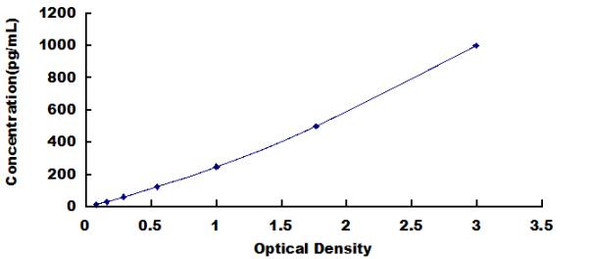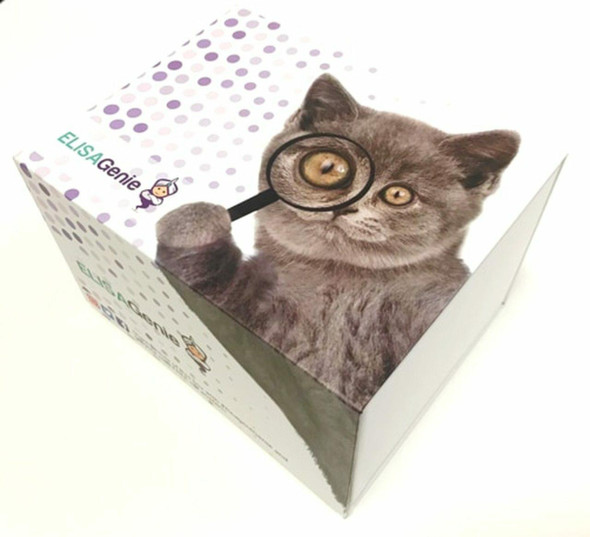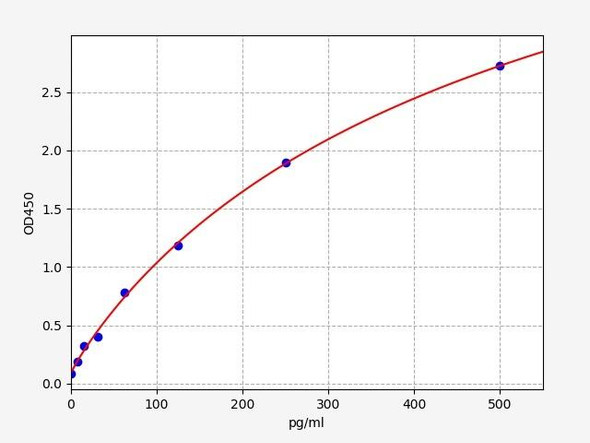Human Cell Biology ELISA Kits 6
Human ANP (Atrial Natriuretic Peptide) ELISA Kit (HUES01727)
- SKU:
- HUES01727
- Product Type:
- ELISA Kit
- Size:
- 96 Assays
- Uniprot:
- P01160
- Sensitivity:
- 4.69pg/mL
- Range:
- 7.81-500pg/mL
- ELISA Type:
- Competitive
- Synonyms:
- NPPA, ANF, ANH, ATFB6, CDD-ANF, PND, Atriopeptin
- Reactivity:
- Human
- Sample Type:
- Serum, plasma and other biological fluids
- Research Area:
- Cell Biology
Description
| Assay type: | Competitive-ELISA |
| Format: | 96T |
| Assay time: | 2.5h |
| Reactivity: | Human |
| Detection Method: | Colormetric |
| Detection Range: | 7.81-500 pg/mL |
| Sensitivity: | 4.69 pg/mL |
| Sample Volume: | 50µL |
| Sample Type: | Serum, plasma and other biological fluids |
| Specificity: | This kit recognizes Human ANP in samples. No significant cross-reactivity or interference between Human ANP and analogues was observed. |
This ELISA kit uses Competitive-ELISA as the method. The microtiter plate provided in this kit has been pre-coated with Human ANP. During the reaction, Human ANP in the sample or standard competes with a fixed amount of Human ANP on the solid phase supporter for sites on the Biotinylated Detection Ab specific to Human ANP. Excess conjugate and unbound sample or standard are washed from the plate, and Avidin conjugated to Horseradish Peroxidase (HRP) are added to each microplate well and incubated. Then a TMB substrate solution is added to each well. The enzyme-substrate reaction is terminated by adding Stop Solution and the color change is measured spectrophotometrically at a wavelength of 450 nm ± 2 nm. The concentration of Human ANP in the samples is then determined by comparing the OD of the samples to the standard curve.
| UniProt Protein Function: | NPPA: Hormone playing a key role in cardiovascular homeostasis through regulation of natriuresis, diuresis, and vasodilation. Also plays a role in female pregnancy by promoting trophoblast invasion and spiral artery remodeling in uterus. Specifically binds and stimulates the cGMP production of the NPR1 receptor. Binds the clearance receptor NPR3. Defects in NPPA are the cause of familial atrial fibrillation type 6 (ATFB6). Atrial fibrillation is a common disorder of cardiac rhythm that is hereditary in a small subgroup of patients. It is characterized by disorganized atrial electrical activity, progressive deterioration of atrial electromechanical function and ineffective pumping of blood into the ventricles. It can be associated with palpitations, syncope, thromboembolic stroke, and congestive heart failure. Belongs to the natriuretic peptide family. |
| UniProt Protein Details: | Protein type:Hormone; Secreted; Secreted, signal peptide Chromosomal Location of Human Ortholog: 1p36. 21 Cellular Component: extracellular space; mast cell granule; perinuclear region of cytoplasm; extracellular region; nucleus Molecular Function:neuropeptide hormone activity; peptide hormone receptor binding; receptor binding Biological Process: cardiac muscle hypertrophy; transcription initiation from RNA polymerase II promoter; cGMP biosynthetic process; negative regulation of systemic arterial blood pressure; positive regulation of heart rate; female pregnancy; response to insulin stimulus; neuropeptide signaling pathway; receptor guanylyl cyclase signaling pathway; regulation of blood pressure; response to hypoxia; gene expression; negative regulation of cell growth; regulation of blood vessel size Disease: Atrial Standstill 2; Atrial Fibrillation, Familial, 6 |
| NCBI Summary: | The protein encoded by this gene belongs to the natriuretic peptide family. Natriuretic peptides are implicated in the control of extracellular fluid volume and electrolyte homeostasis. This protein is synthesized as a large precursor (containing a signal peptide), which is processed to release a peptide from the N-terminus with similarity to vasoactive peptide, cardiodilatin, and another peptide from the C-terminus with natriuretic-diuretic activity. Mutations in this gene have been associated with atrial fibrillation familial type 6. [provided by RefSeq, Sep 2009] |
| UniProt Code: | P01160 |
| NCBI GenInfo Identifier: | 113864 |
| NCBI Gene ID: | 4878 |
| NCBI Accession: | P01160. 1 |
| UniProt Secondary Accession: | P01160,Q13766, Q5JZE1, |
| UniProt Related Accession: | P01160 |
| Molecular Weight: | 153 |
| NCBI Full Name: | Natriuretic peptides A |
| NCBI Synonym Full Names: | natriuretic peptide A |
| NCBI Official Symbol: | NPPA |
| NCBI Official Synonym Symbols: | ANF; ANP; PND; ATFB6; ATRST2; CDD-ANF |
| NCBI Protein Information: | natriuretic peptides A; atriopeptin; cardionatrin; prepronatriodilatin; natriuretic peptide precursor A |
| UniProt Protein Name: | Natriuretic peptides A |
| UniProt Synonym Protein Names: | CDD-ANF; PrepronatriodilatinCleaved into the following 2 chains:Cardiodilatin-related peptide; CDP; Atrial natriuretic factor; ANFAlternative name(s):Atrial natriuretic peptide; ANP |
| UniProt Gene Name: | NPPA |
| UniProt Entry Name: | ANF_HUMAN |
As the OD values of the standard curve may vary according to the conditions of the actual assay performance (e. g. operator, pipetting technique, washing technique or temperature effects), the operator should establish a standard curve for each test. Typical standard curve and data is provided below for reference only.
| Concentration(pg/mL) | O.D | Average |
| 500 | 0.316 0.348 | 0.332 |
| 250 | 0.406 0.466 | 0.436 |
| 125 | 0.637 0.615 | 0.626 |
| 62.5 | 0.924 0.944 | 0.934 |
| 31.25 | 1.352 1.352 | 1.352 |
| 15.63 | 1.809 1.779 | 1.794 |
| 7.81 | 2.15 2.166 | 2.158 |
| 0 | 2.677 2.677 | 2.677 |
Precision
Intra-assay Precision (Precision within an assay): 3 samples with low, mid range and high level Human ANP were tested 20 times on one plate, respectively.
Inter-assay Precision (Precision between assays): 3 samples with low, mid range and high level Human ANP were tested on 3 different plates, 20 replicates in each plate.
| Intra-assay Precision | Inter-assay Precision | |||||
| Sample | 1 | 2 | 3 | 1 | 2 | 3 |
| n | 20 | 20 | 20 | 20 | 20 | 20 |
| Mean (pg/mL) | 26.80 | 74.50 | 197.10 | 29.00 | 80.30 | 208.60 |
| Standard deviation | 1.70 | 3.90 | 8.90 | 1.70 | 4.60 | 11.50 |
| C V (%) | 6.34 | 5.23 | 4.52 | 5.86 | 5.73 | 5.51 |
Recovery
The recovery of Human ANP spiked at three different levels in samples throughout the range of the assay was evaluated in various matrices.
| Sample Type | Range (%) | Average Recovery (%) |
| Serum (n=5) | 86-100 | 92 |
| EDTA plasma (n=5) | 94-104 | 99 |
| Cell culture media (n=5) | 92-107 | 99 |
Linearity
Samples were spiked with high concentrations of Human ANP and diluted with Reference Standard & Sample Diluent to produce samples with values within the range of the assay.
| Serum (n=5) | EDTA plasma (n=5) | Cell culture media (n=5) | ||
| 1:2 | Range (%) | 97-111 | 92-108 | 94-108 |
| Average (%) | 103 | 99 | 99 | |
| 1:4 | Range (%) | 90-105 | 85-100 | 95-106 |
| Average (%) | 96 | 92 | 100 | |
| 1:8 | Range (%) | 85-96 | 91-104 | 94-106 |
| Average (%) | 90 | 97 | 100 | |
| 1:16 | Range (%) | 90-104 | 92-103 | 95-108 |
| Average (%) | 96 | 97 | 101 |
An unopened kit can be stored at 4°C for 1 month. If the kit is not used within 1 month, store the items separately according to the following conditions once the kit is received.
| Item | Specifications | Storage |
| Micro ELISA Plate(Dismountable) | 8 wells ×12 strips | -20°C, 6 months |
| Reference Standard | 2 vials | |
| Concentrated Biotinylated Detection Ab (100×) | 1 vial, 120 µL | |
| Concentrated HRP Conjugate (100×) | 1 vial, 120 µL | -20°C(shading light), 6 months |
| Reference Standard & Sample Diluent | 1 vial, 20 mL | 4°C, 6 months |
| Biotinylated Detection Ab Diluent | 1 vial, 14 mL | |
| HRP Conjugate Diluent | 1 vial, 14 mL | |
| Concentrated Wash Buffer (25×) | 1 vial, 30 mL | |
| Substrate Reagent | 1 vial, 10 mL | 4°C(shading light) |
| Stop Solution | 1 vial, 10 mL | 4°C |
| Plate Sealer | 5 pieces | |
| Product Description | 1 copy | |
| Certificate of Analysis | 1 copy |
- Set standard, test sample and control (zero) wells on the pre-coated plate and record their positions. It is recommended to measure each standard and sample in duplicate. Note: add all solutions to the bottom of the plate wells while avoiding contact with the well walls. Ensure solutions do not foam when adding to the wells.
- Add 50 µL of Standard, Blank or Sample to their respective wells. The blank well is added with Sample / Standard dilution buffer.
- Immediately add 50 µL of Biotin-detection antibody working solution to each well.
- Cover with a plate seal and gently tap the plate to ensure thorough mixing. Incubate for 45minutes at 37 °C.
- Aspirate or decant the solution from the plate and add 350 µL of wash buffer to each welland incubate for 1-2 minutes at room temperature. Aspirate the solution from each well andclap the plate on absorbent filter paper to dry. Repeat this process 3 times. Note: a microplatewasher can be used in this step and other wash steps.
- Add 100 µL of HRP Conjugate working solution to each well and over with a plate seal. Incubate for 30 minutes at 37 °C.
- Repeat the aspiration/wash process 5 times according to step 5.
- Add 90 µL of the Substrate reagent to each well and cover with a new plate seal. Incubatefor approximately 15 minutes at 37 °C and protect from light. The reaction time can beshortened or extended according to the colour change, but not by more than 30 minutes. Whenapparent gradient appears in standard wells, terminate the reaction.
- Stop: Add 50 µL of Stop Solution to each well (wells will develop a yellow color immediately). Note: Adding the stop solution should be done in the same order as the substrate solution.
- Determine the optical density (OD value) of each well immediately with a microplate readerset at 450 nm. In advance, preheat the instrument and set the testing parameters.






